Homer Wick, Date & Location Unknown (Source NHH via Woodling)
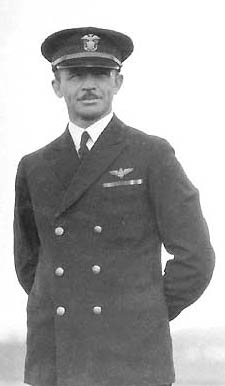 |
Homer Wick landed once at Tucson, Monday, August 19, 1929. He flew an unidentified Boeing F2B. Based at San Diego, CA aboard the U.S.S. Saratoga, he arrived amidst nineteen other naval aviators, each signed into the Register on the middle third of page 112. Other than the first six who signed their own names, the rest were entered by an unknown hand all at once. Please direct your browser to the link and review page 112. There you'll see that signers Chourre through Wick comprise the group of twenty. They all remained overnight at Tucson, departing the morning of the 20th for El Paso, TX.
What were they doing at Tucson all at once? They were on a grand cross-country flight headed from San Diego to Cleveland, OH and back to participate in the National Air Races (NAR) held August 24th-September 2nd at Cleveland that year. Lt. Cdr. Homer Wick was commanding officer of Squadron No. 1 based on the Saratoga.
Wick brought his entire squadron through Tucson on behalf of the NAR. During the 1920s and 1930s, the Navy ordered numerous activities by its personnel, ships and airplanes to build confidence in the naval force among the U.S. citizenry, to provide real-life training for personnel, as well as to encourage recruitment.
To participate in the NAR was a natural complement to such activites. To do so, Wick was in charge of a significant, Golden Age, cross-country logistical exercise, one that involved aircraft husbandry, fuel (over 1,100 gallons of gasoline were required per stop), security, personnel morale, housing and feeding, flight planning, weather and schedule deadlines. It was a good learning experience for him, too, which would come in handy later in his successful Navy career (see below).
Because he was in charge of the gaggle, I'll use Wick's page to go into the details around the personnel, the mass movement of their aircraft, and the general results obtained.
THE PERSONNEL
Below is a tabulation of Navy pilots who landed, in order, at Tucson August 19th, and further accompanied Wick to Cleveland. Each of the Sikorskys carried five mechanics each. The hyperlinks take you to their individual biography pages. Almost all these pilots would go on to enjoy substantial, and in some cases heroic, careers with the Navy. Some would die too young. Among them is a significant number who would become flag rank officers later in their careers. As you can see from the table, I have biographical information for all the red-linked people and aircraft. If you can help with the others, please let me KNOW. Significantly, pilot Emile Chourré maintained a scrapbook of the group's activities at the NAR, and a log of A-8090. Please be sure to review Chourré's biography where you will find some of those artifacts exhibited.
For perspective, significant to this group, there were 281 landings by fellow U.S. Navy pilots at Tucson during the time the Register lay open on the desk there between 1925 and 1936. Sure, some pilots, but not many, landed more than once over the decade, so the total number of individual pilots is a few less than 281. But their landings represent about 8% of all landings at Tucson, military, commercial and civil, during the period. Wick's squadron was the largest landing by a single group of Navy pilots. They were the "Desert Navy" at Tucson on that day.
Scrambled Eggs
 |
Among the gentlemen listed above, there probably isn't another sample of officers you could pick at random from the Register that have a higher incidence of superior achievements and higher ranks in military service. In the vernacular, there was a lot of "scrambled eggs" earned among this group. Image, right, shows by the pointer the embroidery, known commonly as scrambled eggs, on the brim of a naval officer's cap.
THE AIRCRAFT AND THEIR CROSS-COUNTRY FLIGHT
Two types of aircraft made the journey with Wick, the Boeing F2B and the Sikorsky militarized S-38, designated the XPS-2 by the Navy. The F2B first flew as a prototype in November, 1926 and it was adopted by the Navy in January, 1928. Thirty-two production aircraft were made, all going to the Navy, making the ones that visited Tucson representative of over half that production run. The F2B was capable of 158MPH and carried machine guns and bombs.
The Sikorsky XPS-2 amphibious (meaning it could land on both land and water) aircraft represented the only two the company made for the Navy. The commercial version could carry 10 people at 104 knots, behind two Pratt & Whitney 400HP engines. The militarized version carried gunner's ports fore and aft. That gun hardware and ammunition reduced the passenger payload.
More broadly, the San Diego Naval Air Station (NAS) and the Saratoga were not the only stations to participate in the NAR. Below, from a Bureau of Aeronautics Newsletter of the period, are the announcements of several groups of Navy and Marine Corps aircraft and pilots dispatched to Cleveland. The first example, from page two of the September 11, 1929 Newsletter describes preparations by Wick's fleet aircraft in San Diego. This rehearsal took place three days before we find them all at Tucson.
Bureau of Aeronautics Newsletter, September 11, 1929, Page 2 (Source: Webmaster)
 |
From page 9 of the same Newsletter, the NAS Anacostia contingent is described as a 10-plane flight. Only the first sentence is relevant, but I left the rest of the paragraph intact, because it mentions Herr Eckener, the captain of the Graf Zeppelin, as well as other VIPs.
Bureau of Aeronautics Newsletter, September 11, 1929, Page 9 (Source: Webmaster)
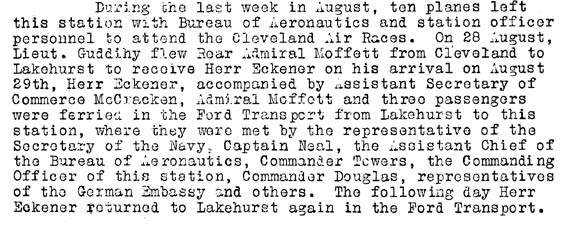 |
Below, from page 10, the Marine Corps sent two flights of Curtiss F7C-1 fighter aircraft from Quantico, VA to Cleveland.
Bureau of Aeronautics Newsletter, September 11, 1929, Page 10 (Source: Webmaster)
 |
Finally, from page 12 of the September 11th Newsletter, the Great Lakes, IL station sent its representatives.
Bureau of Aeronautics Newsletter, September 11, 1929, Page 12 (Source: Webmaster)
 |
Curiously, no mention was made in later issues of the Newsletter that the aircraft and pilots returned to their respective stations. Regardless, the Navy was well-represented at Cleveland in 1929.
Ada (OK) Evening News, August 20, 1929 (Source: Woodling)
 |
News articles tracked the progress of the San Diego fleet across the country. At right, from the Ada (OK) Evening News, the group is placed in Tucson overnight, departing at 6:00AM. Their itinerary is clearly cited as San Diego, Tucson, El Paso, Kansas City, Cleveland. But please direct your browser to Emile Chourré's page linked in the table above. There you will find the actual stops logged on a chart that Chourré drew in his log of A-8090. The actual itinerary was San Diego, Tucson, El Paso, Midland, TX, Dallas, Muskogee, OK, Kansas City, Belleville, IL, Dayton, OH, then Cleveland.
Below, the Evening Tribune, Albert Lea, MN, August 21, 1929 cites a stop at Midland, TX as well. with the next stop at Dallas, TX. The distance across Texas remains today a long, long flight for a small plane, taking most of the day and a couple of fuel and comfort stops to cover the distance.
Navy Planes Go On to Cleveland
Midland, Texas, Aug. 21.—(AP)—
A squadron of 20 navy planes, en route to Cleveland from its base at San Diego, Calif., to participate in aerial maneuvers at the national air races, spent the greater part of Tuesday flying over Texas soil. The group, commanded by Commander Homer Wick, took off from Tucson, Ariz, at 6 a. m. (mountain time) yesterday. About four hours later the first refueling stop was made at El Paso. The squadron arrived at the Midland airport at 1:10 p. m. After a stop of 35 minutes during which the planes were refueled, the squadron again took the air for Dallas where it was scheduled to remain overnight.
|
To continue, the Dallas Morning News of Wednesday, August 21, 1929, below, captured the entourage at Love Field, Dallas, TX the previous day. It describes it as, "...a full squadron of eighteen Boeing pursuit planes and two giant Sikorsky amphibians." They arrived at Dallas with the majority landing between 5 and 6PM; a good day's flight from Tucson on Tuesday. Over a thousand cars were parked along the edge of the field to witness the landings.
The top photograph in this article shows some of the Boeings parked on the flight line. The crews and local dignitaries pose in the second frame, and one of the Sikorsky amphibians completes the third frame. Wick is pictured in the last inset.
Dallas (TX) Morning News, August 21, 1929 (Source: Woodling)
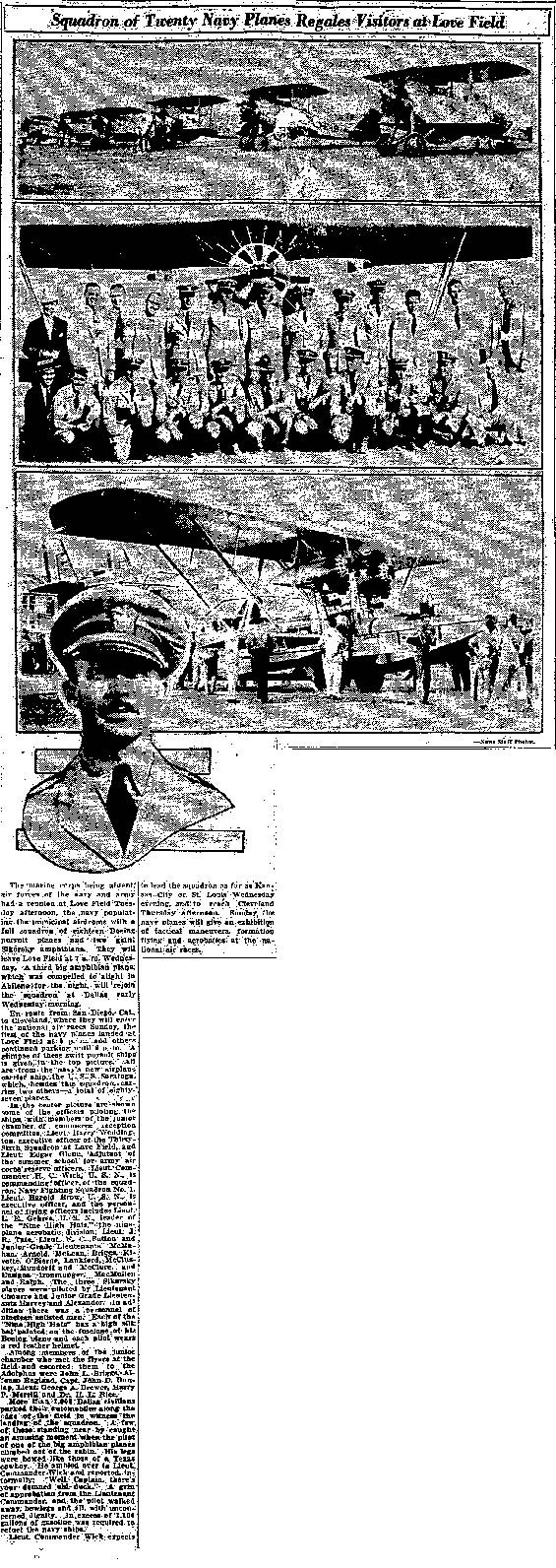 |
Note the mention in this article of Register pilot Harry Weddington. who was executive officer of the 36th squadron at Love Field. Note also the mention that a, "... third big amphibian plane, which was compelled to alight in Abilene for the night, will rejoin the squadron at Dallas early Wednesday morning."
Wick's plan was to lead his squadron to Kansas City or St. Louis, MO by Wednesday evening (the 21st), and to reach Cleveland by the afternoon of the 22nd. According to the article, on Sunday the 25th, they were scheduled to, "... give an exhibition of tactical maneuvers, formation flying and acrobatics at the national air races."
As it turns out, it was Kansas City. Below, courtesy of site visitor Jeffrey Welsh, are two views of the Sikorskys taken by his grandfather at Kansas City. The tail number on this first one is unreadable, but two of them wore squadron numbers IJ-21 and IJ-22. The tall gentleman is Mr. Welsh's grandfather.
Sikorsky, Ca. August 21, 1929 (Source: Welsh)
 |
The identifiers for the Sikorskys known to have accompanied Wick were A-8287, A-8089 and A-8090 (flown by Emile Chourré). Below, with just-readable tail number, is A-8287 caught up from Abilene (see above).
Sikorsky IJ-22, Ca. August 21, 1929 (Source: Welsh)
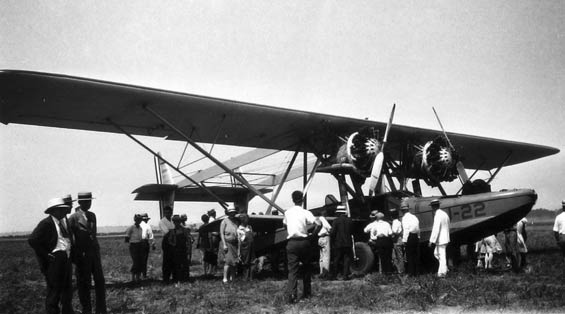 |
Finally from Mr. Welsh, the Boeing F2B A-7428 flown by Charles Ironmonger. It is in the foreground. While A-7428 is readable on the rudder, the numbers on the rudders of the other Boeings are either blocked or otherwise unreadable. IJ-21, AKA A-8090, sits in the background.
Boeing F2B, A-7428, Foreground, Ca. August 21, 1928 (Source: Welsh)
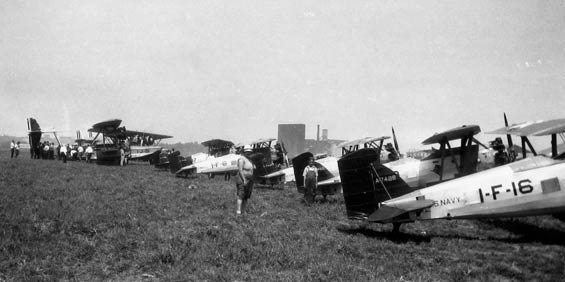 |
Below, from the San Antonio, TX Express of Thursday, August 22, 1929, their stop at Kansas city is logged as follows. Note that Muskogee, OK was added to the itinerary. Harold Brow's name was again misspelled.
17 NAVY AIRPLANES
LAND AT KANSAS CITY
(Associated Press)
KANSAS CITY, Aug. 21.—Fifteen sleek and speedy Boeing pursuit planes, "war birds" of the Navy, and two giant twin-motored Sikorsky amphibians, en route to the National air races at Cleveland, arrived at the municipal airport here today. The planes carried 23 naval officers and 19 enlisted men, en route from San Diego, Calif. They took off this morning from Dallas. Tex., and made a short halt at Muskogee, Okla. After spending the night in Kansas City the squadron will depart early tomorrow for St. Louis, the next stop on the journey. Minor troubles today delayed four of the ships comprising the entire group and they did not arrive with the main body. A Boeing ship returned to Dallas shortly after the takeoff there because of low oil pressure. Two other planes of the section also returned.
Another plane which left California with the others was delayed at Abilene, Tex., by inclement weather and has not rejoined the squadron. The entire squadron comprises the Navy fighting squadron No. 1 from the aircraft carrier Saratoga. Lieutenant Commander Homer Wick is in
Command. Lieut. Harold Brown, whose name is closely linked with many naval air speed events, is the executive officer.
|
THE NINE HIGH HATS
The "acrobatics" obligation by the Navy at the NAR was handled by nine of the F2B pilots. The Charleston (WV) Gazette of Sunday, August 25, 1929 carried a syndicated article describing the "Nine High Hats." One of their sensational feats was all nine aircraft performing loops in three sections while each section was tied together at their wingtips by 3/4" ropes 400 feet long. Each of their aircraft had a high silk hat painted on the fuselage (note the one painted under the top wing strut on the second airplane back in the photo above), and the pilots each wore a red leather helmet.
These helmets contrasted nicely against the white-painted fuselage and the High Hat's airplanes' red tails, red fuselage stripes and yellow upper wings. Add the color to the colossal noise and dust of a squadron of Pratt & Whitney Wasp 425HP radial engines and Wick and company must have made a grand entrance, display and departure everywhere they landed. We can imagine the impact they had on recruitment and public good will. Below, from the link, a color image of one of their F2B-1 aircraft.
Navy Boeing F2B-1 Aircraft in "Nine High Hats" Livery (Source: Web)
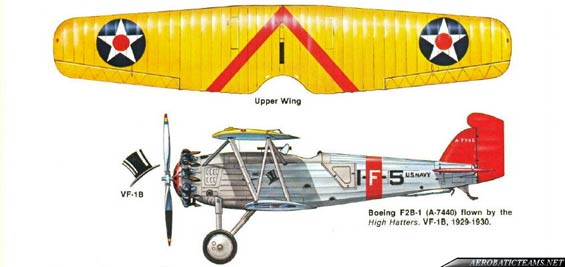 |
Below, from the San Diego Aerospace Museum (SDAM), the "Nine High Hats" in exhibition. Note the knotted ropes between the wingtips. I've never seen it mentioned, but in case of emergency they must have had some way from inside the cockpit to release the ropes from the wingtips.
The "Nine High Hats," Ca. 1929 (Source: SDAM via Woodling)
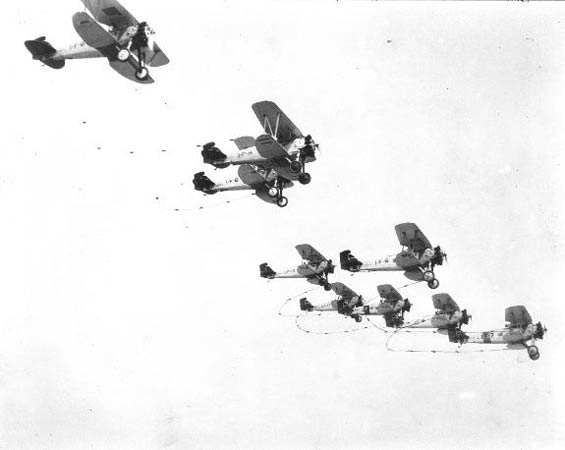 |
From the Gazette, Leslie Gehres was leader of the first section of three, which included wingmen Frank O'Bierne and Frederick Kivette. The second section was headed by J.R. Tate with wingmen C.W. McClusky and W.M. McMullen. The third section was led by F.C. Sutton with wingmen C.K. Lankford and G.T. Mundorff. All these pilots are pictured in the photograph below, in section order. This is an Official U.S. Navy Photograph, now in the collections of the U.S. National Archives. The airplane is identified as a Boeing F2B-1.
The "Nine High Hats," August 16, 1929 (Source: NHH via Woodling)
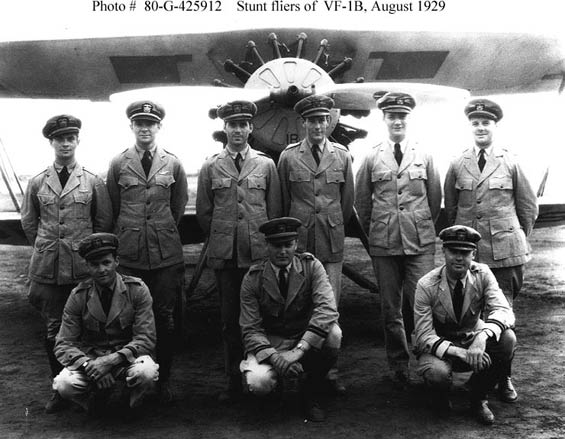 |
The "Three Sea Hawks," Ca. 1928 (Source: AAHSJ via Woodling)
 |
The section leaders as cited above (kneeling in front, left to right) are Lieutenant (Junior Grade) Frank C. Sutton, USN; Lieutenant Leslie E. Gehres, USN; Lieutenant Jackson R. Tate, USN. Over their shoulders are their wingmen, (left to right): Lieutenant (Junior Grade) George T. Mundorff, Jr., USN; Lieutenant (Junior Grade) Creighton K. Lankford, USN; Lieutenant (Junior Grade) Frank O'Beirne, USN; Lieutenant (Junior Grade) Frederick N. Kivette, USN;
Ensign William H. McMullen, USNR; Lieutenant (Junior Grade) Clarence Wade McClusky, Jr., USN. All these officers' biographies are linked from the table in THE PERSONNEL section at the top of this page.
This wasn't the first time the navy was repesented at the NAR. The team calling themselves the "Three Sea Hawks" performed at the 1928 NAR. At right, a painting of the Sea Hawks from the back cover of the summer, 1986 issue of Journal of the American Aviaition Historical Society (AAHSJ). The Sea Hawks also performed aerobatics with Boeing F2B's roped together. This team of three consisted of William V. Davis, Jr., D.W. Tomlinson and A.P. Storrs. Tomlinson and Storrs are Register pilots. Davis' fame came when he flew as the navigator for the first successful non-military flight across the Pacific Ocean in August, 1927 with Register pilot Art Goebel. Doing so, Goebel and Davis won the famous Dole Race. The "Three Sea Hawks" disbanded and were replaced by the "Nine High Hats" by 1929.
As might be expected, these elite flyers enjoyed access to the latest technologies available. Below, from Popular Aviation (PA) magazine, October, 1933 is an article that describes a new iteration of aircraft for the "High Hats."
Popular Aviation, October, 1933 (Source: PA)
 |
THE NATIONAL AIR RACES
| PLACE |
PILOT |
1st |
W.E. Arnold |
2nd |
C. Ironmonger |
3rd |
T.C. Sutton |
4th |
C. Lankford |
5th |
L.E. Gehres |
6th |
W. McMullen |
7th |
W. Harvey |
8th |
G.T. Mundorff |
** |
H.C. Wick |
** |
D.S. MacMahan |
** |
C. Briggs |
** |
C.W. McClusky |
** |
H. Brow |
** |
E.R. McLean |
Out |
J.R. Tate |
Out |
J.S. McClure |
Besides performances by the High Hats, our pilots competed en masse at the Races. Event No. 21 of the NAR was the Navy Pursuit Race. It took place on August 30th and covered 100 miles in ten, 10-mile laps.
According to the Aircraft Yearbook for 1930, sixteen navy pilots competed and placed according to the table at left. The double asterisk means that six pilots were disqualified because of fouled pylons. "Out" means they dropped out of the competition for some reason, perhaps engine problems.
First-place pilot Arnold showed an average speed of 127.58MPH for his win. Eighth-place pilot Mundorff showed 120.40MPH. The Yearbook did make some errors in the spellings of some of the names (assigning "Nimdorf" to Mundorff, for example).
W. Harvey, who placed 7th, while not signed in the Register, was the pilot of a third Sikorsky amphibian (A-8287) that accompanied the other two.
---o0o---
Homer Wick married Mary Eleanor Evins March 24, 1920, in Atlanta, GA. Their son, John Glen Wick graduated from the Naval Academy in 1947.
Wick was involved in the Schneider Cup Races in 1926. Below, a photograph taken after the Races. Wick is on the far left, with Rear Admiral William A. Moffet next to him. At far right is Major Mario de Bernardi, Royal Italian Air Force, who won the race. Second and fourth places were taken by the U.S. Navy, Register pilot W.G. Tomlinson being one of them.
According to The New York Times of November 12, 1926, Wick was captain of the American team for the Race (and was taken sick just before the event with what was called "la grippe"). Besides Tomlinson, Register pilot Christian Schilt was a member of the team. Moffet was the Chief of the Bureau of Naval Aeronautics.
Homer Wick (L), Schneider Cup Races, 1926 (Source: NHH via Woodling)
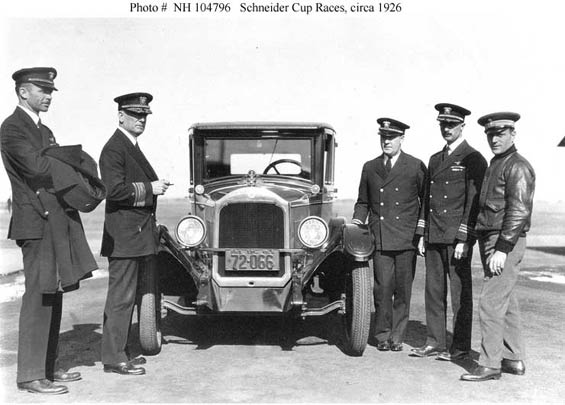 |
After Charles Lindbergh's trans-Atlantic flight in May, 1927, his airplane was carried back to the U.S. by ship and delivered to Washington, DC. The New York Times of June 17, 1927 cites Wick as the commandant of the Anacostia Naval Air Station at the time, who guided Charles Lindbergh back to New York after he flew from there to Washington, DC to pick up his "Spirit of St. Louis."
Wick's reassignments during the late 1930s were quick and were affected by illness. The Seattle Times reported a string of them. On April 2, 1936 was reported his assignment from the U.S.S. Wright to the Naval War College, Newport, RI. And on May 29th, he picked up additional duty as commander again of the U.S.S. Wright. On May 10,1937 he was transferred from the Naval War College, "... to continue treatment Naval Hospital, Washington." On September 8, 1938 his order read, "... continue treatment Naval Hospital, Washington, DC, on discharge treatment, to home, relieved all active duty."
I have no information regarding his service during WWII. If you can help, please let me KNOW.
Wick died relatively young on June 15, 1951. His obituary from the Cleveland Plain Dealer of June 16, 1951 reads:
"Capt. Homer C. Wick, who retired from the United States Navy in 1948 and was staff commander in chief of the Pacific fleet under Admiral Chester W. Nimitz, died yesterday in Washington. He was 61. Capt. Wick is survived by his wife, Mary; two sons, Lieut. Homer C. Wick, Jr., a navy doctor, and Lieut. John G. Wick, with the Naval Air Corps in Jamaica; two sisters, Mrs. Helen W. Sheddon of Atlanta, Ga., and Mrs. Margaret W. Kaby of Columbus, O., and a brother, Donald D. Wick, a lawyer here. Services will be held Tuesday at Arlington Cemetery." |
---o0o---
THIS PAGE UPLOADED: 02/07/12 REVISED: 06/25/14
|


















